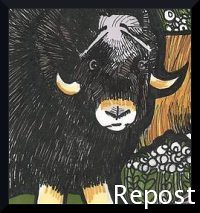 Until very recently, no direct ancestors of the red panda (Ailurus) were known. Most paleontologists link Ailurus with previous, raccoon-like (procyonoid) fossil animals - Cynarctis, Phlaocyon, Aletocyon - mainly by the similarities in their molars.
Until very recently, no direct ancestors of the red panda (Ailurus) were known. Most paleontologists link Ailurus with previous, raccoon-like (procyonoid) fossil animals - Cynarctis, Phlaocyon, Aletocyon - mainly by the similarities in their molars.
A closer relative was described in the 1970's, an animal 50% larger than Ailurus found in Europe and North America, appropriately named Parailurus anglicus. Researchers concluded from these fossils that the red panda's ancestry was based solely in North America:
Intermediate forms between Parailurus and Ailurus are not known. The smaller size diminished range of Ailurus suggests that it may represent a specialized offshoot of the early ailurine lineage (and possibly even of an Asian form of Parailurus) that survived the Pleistocene glaciations in the mountain refugia of southern China (Pen, 1962).
But in 2003, paleontologists in Japan found the first molar evidence of another species of Parailurus in Asia around the same time period as the European and North American fossils, complicating the ancestry of Ailurus a bit further. If the red panda's ancestors came from North America, why were fossils of another species found in Japan?
It largely depends on how you take the evidence. If the Pleistocene glaciations were indeed responsible for the spread of Parailurus throughout the northern hemisphere, then perhaps the populations were isolated during the interglacial periods and speciated.
In 2004, paleontologists working in the Gray Fossil Site in eastern Tennessee published an article about a sturdy ancestor of Ailurus dating from the late Miocene period (4.5 - 7 Ma), further evidence supporting the western world's standing as cradle for the red panda.
Pristinailurus bristoli, as the animal has come to be known, could not have fed on bamboo, as the plant is not native to North America. However, there was a species of river cane extant at the time that Pristinailurus may have eaten, and the modern red panda is known to be a bit more versatile in diet than its cousin, the giant panda.
Browse all posts about the red panda
Resources:
Roberts, M.S. and J.L. Gittleman. 1984. Ailurus fulgens . Mammal Species, No. 222:1-8
Tedford, R.H., and Gustafson, R.P., 1977, First North American record of the extinct panda Parailurus: Nature v. 265, p. 621-623.
Wallace, S.C., and Wang, X., 2004, Two new carnivores from an unusual late Tertiary forest biota in eastern North America: Nature, v. 431, no. 7008, p. 556-559.